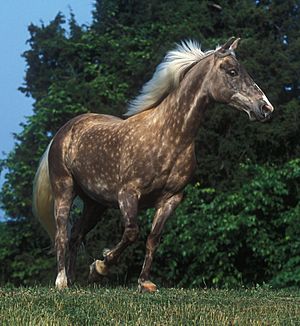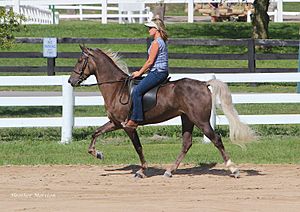Rocky Mountain Horse facts for kids

Silver dapple-colored Rocky Mountain Horse
|
|
| Distinguishing features | Singlefoot ambling gait |
|---|---|
| Alternative names | RMH |
| Country of origin | United States |
| Breed standards | |
| Rocky Mountain Horse Association | Breed standards |
| Horse (Equus ferus caballus) | |
The Rocky Mountain Horse is a special horse breed from Kentucky, a state in the United States. Even though its name sounds like the Rocky Mountains, this horse actually came from the Appalachian Mountains.
Around 1890, a special male horse (called a stallion) was brought to eastern Kentucky. This horse helped start the breed. Later, in the mid-1900s, a stallion named Old Tobe became very important. Most Rocky Mountain Horses today can trace their family back to him!
In 1986, a group called the Rocky Mountain Horse Association was created. By 2005, they had registered over 12,000 horses. These horses are famous for their "chocolate" coat color. They also often have a light, "flaxen" mane and tail. This special look comes from a rare silver dapple gene.
Another cool thing about them is their unique way of moving. It's a smooth, four-beat ambling gait called the "single-foot." These horses were first used for many jobs, like riding, pulling carts, and light farm work. Today, they are mostly used for trail riding and helping with cattle.
Contents
What Makes Rocky Mountain Horses Special?
Rocky Mountain Horses are usually between 14 and 16 hands tall. (A hand is a way to measure a horse's height, about 4 inches or 10 cm). Any solid color is allowed for these horses. But many people really like the dark brown "chocolate" color. This color often comes with a pale, "flaxen" (light yellowish) mane and tail.
This special "chocolate" color happens because of a rare silver dapple gene. This gene changes a black coat to a dark brown. It also makes the mane and tail much lighter. This gene is rare, but it's found in over a dozen different horse breeds, including the Rocky Mountain Horse.
These horses can have small white markings on their bodies. But markings on their legs can't go above their knees. Rocky Mountain Horses are known for being tough. They can handle cold mountain winters well. People also love them because they are friendly and good-natured.
Eye Health
Rocky Mountain Horses have a higher chance of a genetic eye condition. It's called multiple congenital ocular anomalies (MCOA). This condition means some parts of their eyes didn't develop normally. It can cause a little bit of blurry vision, but it's usually mild. It also doesn't get worse over time. Scientists have found that this eye condition is often linked to the silver dapple gene. Most horses with MCOA also have this gene.
Their Smooth Gait
These horses have a natural, smooth way of moving called the "single-foot." This gait is different from the trot that most horses do. Both the single-foot and the trot are faster than a walk but slower than a canter or gallop.
The single-foot is a four-beat gait. This means each of the horse's four feet hits the ground separately. The trot, however, is a two-beat gait. The single-foot feels very smooth for a rider. This is because the horse always has at least one foot on the ground. This makes the ride less bouncy. It also helps the horse save energy.
Many horse breeds can do a four-beat ambling gait. Some can also trot. A Rocky Mountain Horse can use its single-foot gait to travel over rough ground at about 7 miles per hour (11 km/h). On smooth ground, they can go up to 16 miles per hour (26 km/h). This faster speed is called the rack. For comparison, a normal trot is usually 6 to 8 miles per hour (10 to 13 km/h).
The History of the Rocky Mountain Horse
Eastern Kentucky is famous for its gaited horse breeds. These horses came from a mix of Spanish horses from the south and English horses from the north. Other gaited breeds like the American Saddlebred and Tennessee Walking Horse also came from this same area and mix of horses.
The Rocky Mountain Horse's story is similar to the Kentucky Mountain Saddle Horse. Sometimes, both are called "Mountain Pleasure Horses." The Rocky Mountain Horse started in eastern Kentucky. This happened when a special foundation stallion was brought to the Appalachian Mountains around 1890.
This horse was a colt (young male horse) when he arrived. Old stories say this "Rocky Mountain Horse" had the chocolate color and flaxen mane and tail we see today. He also had the single-foot gait. He was used to breed with local mares (female horses). Because he was bred in a small area, a unique type of horse developed there.
Old Tobe's Legacy
This first stallion had a descendant named Old Tobe. Old Tobe became known as the father of the modern Rocky Mountain Horse breed. A man named Sam Tuttle, from Spout Springs, Kentucky, owned Old Tobe. Sam Tuttle was a very important breeder of these horses for most of the 1900s. He helped keep the breed going during tough times like the Great Depression and World War II.
After World War II, many horse numbers went down in the US. But Sam Tuttle kept his herd. He continued to use Old Tobe for breeding. Old Tobe was even used for trail rides at Natural Bridge State Resort Park until he was 34 years old! Old Tobe lived to be 37. Because the breed has the single-foot gait, it's possible they are partly related to the Narragansett Pacer. This old breed was known for passing on its gaited ability to other American horses.
Growing the Breed
In 1986, the Rocky Mountain Horse Association was formed. Their goal was to help the breed grow and become more popular. At first, only 26 horses were registered. But by 2015, the association had registered over 25,000 horses! The breed has now spread to 47 states and 11 countries.
To be registered, a foal (baby horse) must have its parents checked using DNA tests. Also, when horses are about two years old, they must be inspected. This makes sure they have the right look and gait for the breed. The Rocky Mountain Horse is currently on a "Watch" list by the American Livestock Breeds Conservancy. This means there are fewer than 15,000 of them worldwide. Also, fewer than 800 new horses are registered each year in the US.
These horses were first used for many jobs on farms in the Appalachian foothills. They pulled plows and buggies, worked with cattle, and were ridden by everyone. Today, they still work with cattle. They are also popular for endurance riding and just riding for fun. Their smooth gait and calm nature make them great for older riders and people with disabilities. Every September, the Kentucky Horse Park hosts a big show for Rocky Mountain Horses.
See also
 In Spanish: Rocky Mountain Horse para niños
In Spanish: Rocky Mountain Horse para niños



